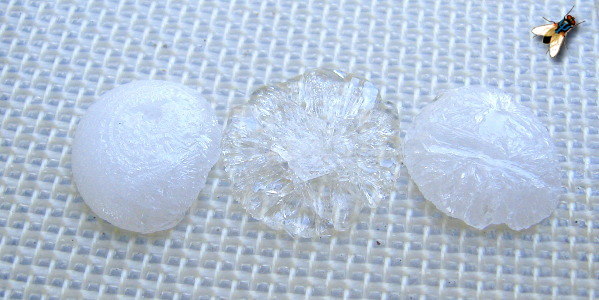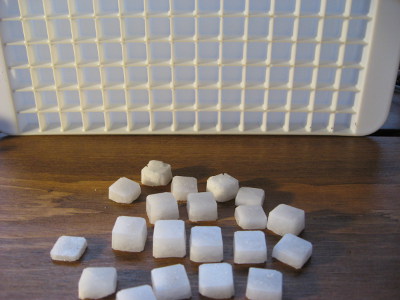Tips & Tricks for making xylitol hard candies
Useful equipment
- Infrared no touch thermometer: I use this to get the temperature of the surroundings as well as the cooling xylitol so I know when to "seed" with crystals. It's also handy for getting temps of ovens, heating vessels and cold spots when ghost hunting.
- Digital probe thermometer: When you are experimenting with a new heat source or new procedure a programmable probe thermometer is really handy. I keep the probe tip touching the bottom and set the alarm to go off at the temperature I want or Do NOT want the xylitol to reach. The ir thermometer is better for figuring out localized hotspots.
- Mortar and pestle: I sometimes use this to grind the xylitol to a fine powder before "seeding". This makes the candies smoother ... when you seed with the larger crystals they only partially embed and make the top a little coarse. Personally I don't care and only do this for the candy I make for mom 'cuz she's my mommy and she'll complain if I forget.
Seeding
The best time/temp to seed will depend on the texture you prefer, the flavorants {aka impurities} you've added and your room temperature.
Any time the temperature of your xylitol falls below 197.6°F (92°C) crystals 'may' begin to form. What you want is to form a supercooled liquid which is a substance that is liquid below it's melting point {aka freezing point}. In the case of xylitol using the siguie protocol, the closer to that temperature you initiate crystallization the larger the crystals will be and the grittier the final product {aka like a sugar cube}. If you allow the xylitol to cool to say 65°F {my room temp} THEN initiate crystallization you will have a much harder "glass like" texture.
Personally I go for something in between and as an example; 25g of xylitol with 5 drops of LorAnn's lime oil {not the key lime} is the perfect texture {for me} when I seed it at ~85°F and my room temperature is 65°F.
This is kind of a trick and really only works for fairly thin sticks, like the ones made from my small scale procedure. With thicker castings the texture depends more on the room temperature since that is what governs crystal formation over the 24 to 48 hour time period BUT it's a good trick.
The texture of the final candy is determined by the crystal structure. Larger crystals produce gritty sugar cube like textures while small fine crystals produce glass like textures. The one exception is creating a single ginormous crystal which is extremely hard like glass but that's another show.
Here's an example of crystal structure in pasteles ...

I believe most people will prefer the smooth pastele on the left which is what I shoot for; this texture is smooth and too hard to comfortably bite right away but after a little time is chewable. The one on the right is a little gritty and people who like chomping on hard candies right away may prefer that. The one in the middle is like chewing shards of glass ... for whatever unknowable reason my parents like it that way.
To determine what temperature you need to seed your candies at will depend on your conditions, the texture you want and the flavorants used. If you find you enjoy making these things I recommend using the cardboard mould holders for that little extra bit of thermal insulation AND getting an IR thermometer. In the meantime waiting 20 to 30 minutes after you pour will probably put you in the ballpark and you can just play with time to get the texture you want.
Cooling
Do not try blowing air over these things, agitation and/or dust particles will just initiate crystallization prematurely. If you want you can use something like copper pipes to prop the sides of the mould up. These will quickly remove heat by conduction but just don't try icing them or cooling them in the fridge first you will just generate condensation and ruin your castings.
Things I've Done
If you are interested in making nicer looking candies you can use prefab moulds designed for hard candy making. However, if you are really cheap you can get away with things like mini ice cube trays.

Keep in mind that ice cube trays are meant to handle cold not heat but I got these from Bed Bath and Beyond and they said dishwasher safe so I decided to risk it. For a little insurance I floated the tray in a quarter inch of water and made sure my liquid xylitol was below 250°F (121°C). I then ladled the xylitol in slowly at opposite sections so no one area would stay hot for long.
In short it works, you get a mix of different textures, like with pasteles, and while you still get a few malformed cubes overall they look nice and more professional. The downside is there always seems to be a couple that don't want to pop out.
If you are interested in this I recommend getting good quality hard candy moulds for small relatively flat candies. There is a shrinking issue so things like lollipops will be tricky. Also you may want to try release agents on the mould to make getting them out easier ... I would try cornstarch first but I have not done this myself ... yet.

Colloidal Silver Xylitol Hard Candy
This one is a little tricky since colloidal silver is generally found in aqueous solution and relatively low concentrations. I make my own CS in the 20ppm range and it's relatively simple to just let the water evaporate off first in the heating vessel but you need a lot so it takes a long time and it is problematic. However, if you start with extremely concentrated CS {I make mine at around 1000ppm+} You can simply add 5 drops to your 25g of xylitol then let it heat for atleast 2 hours. That is how long it takes to drive off that little bit of water from the polar xylitol. If you do not drive off all/enough of the water it will be sugar cube like at best.
After 2 hours I started getting the texture I wanted but I still wait between 2 and 3 hours normally. If you are going to try this be sure your xylitol never goes above 250°F (121°C) ... mine maxs out at 252°F which is close enough for me.
My reason for making colloidal silver xylitol candies is that in theory it could be quite useful to people with mouth problems like bad breath, cavities, gum disease, tooth aches, cold sores or for those just fighting a cold. The tricky part is getting xylitol candies into the 20ppm range but it can be done.
Clove oil {eugenol}
One of the advantages of the siguie method {that whole cup warmer thang} is you can use the hot xylitol as a solvent. Once your xylitol is hot drop in a few whole cloves, 3 to 5 depending on how fresh they are. You will see the liquid xylitol quickly turn yellow as the eugenol {essential oil of clove} and a few other compounds are extracted. There is no easy way to tell how long you need to heat the cloves this way so I just dip a fork in, pull it out and let it cool for a second then taste it. When it tastes "right" I use a clean or atleast dried fork to pull out the cloves and then cast in a mould like usual.
Clove oil has many benefits but here I was going for it's pain relief effect. I think it works and I couple it with the colloidal silver protocol ... just add the clove near the end of the 2+ hours or the oil will mostly evaporate ... and the end result is a xylitol clove oil hard candy with colloidal silver.
I have never had need of this but my friends swear it works but you really can't tell which component is effective or if it's a placebo thing. I just wanted to see if I could make it ... also clove candy isn't very tasty and yes I really did do the math to make 20ppm cs candies, check out the concentrator link for some useful equations.
Cinnamon Xylitol Hard Candy
This one is easy and like the clove candy above involves simply dropping a few pieces of cinnamon stick into the melted xylitol, then taste for when you think it is ready, remove the sticks {you only need a few little pieces from one stick}, pour, seed, wait and enjoy.
It should go without saying BUT Do NOT use powdered clove or cinnamon. Also do not try for eXtreme flavor on the first attempt, I do not know at what point the flavorants will prevent crystallization but too much and they will.
Citrus Rind
Sadly this does not work. I am rather fond of citrus flavored candies and thought extracting the dried rind would work BUT it does not. My guess is that the waxes in the rind are inhibiting crystallization because the food grade oils themselves work fine.
siguie's colloidal silver generator
Colloidal Silver Concentrator {for high ppm}
Colloidal Silver References

